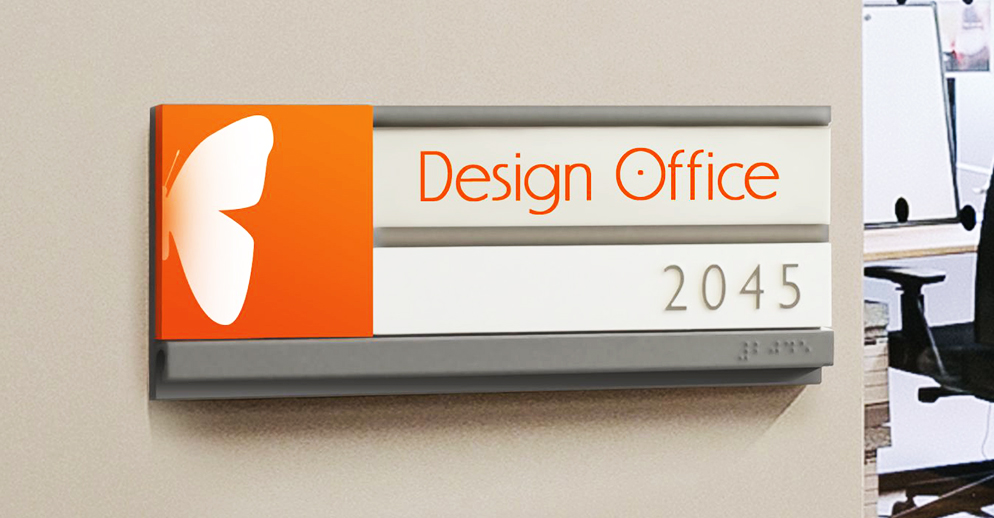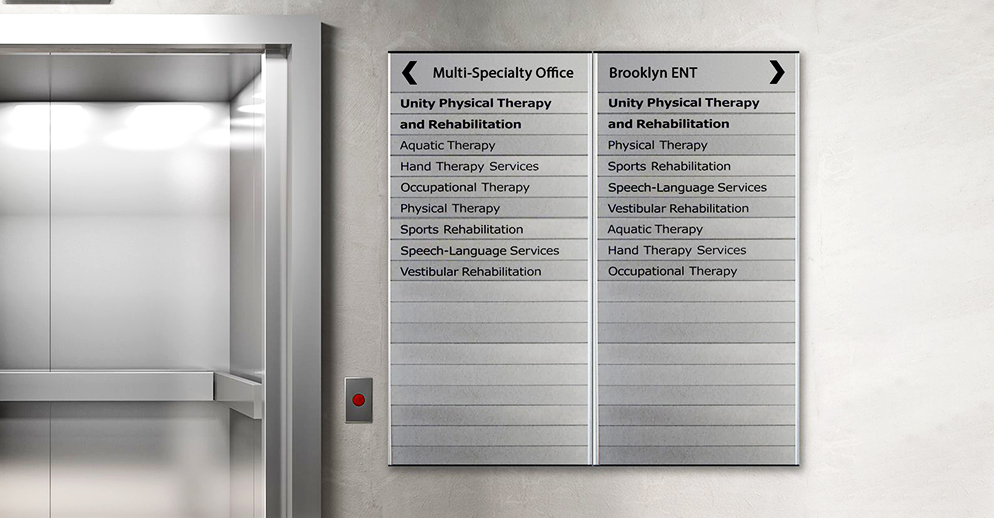Wayfinding signs, otherwise known as directional signage, maybe one of the oldest types of signs in existence. They have the power to inform people of basic directions, as well as give context and build connections between far flung locations. Perhaps most importantly, these signs allow complex images such as maps and floor plans to be easily remembered by literally pointing people in the right direction. In this blog we will be examining interior wayfinding signs in the context of offices, commercial properties, schools and other public buildings.
Rule of Thumb for Directional Signs:
There are two main rules to creating wayfinding signage:
Keep it Simple
Wayfinding signs need to include comprehensive, abridged information using clear and consistent visual messaging, such as landmarks.
Keep it Short
A good directional sign will only show what is relevant to that particular location, hallway, wing or floor (e.g. restrooms to the left past water fountain).

Application of Wayfinding Signage in Offices:
When creating wayfinding signs, there are three main characteristics of how people create mental images of maps in their mind’s eye:
Landmarks
What are recognizable places/things/features in an area? Observable landmarks — such as an atrium or large window, painting or statue, dining area or auditorium — will allow a person to imagine the layout of a building, floor or suite of offices more easily. The larger and more recognizable the landmark, the more useful it will be. Separating different rooms or parts of the building by color are useful ways to let someone instantly know they are in the right place, as well as help new employees and students better memorize how to get from point “A” to point “B”.
Position
In order to find your way in a given place, you will need to know where you are in it. Marking a simple map diagram with a simple red dot labeled “You Are Here” will help someone know where they are. Maps and directional arrows should always be presented in the same direction a person is facing while looking at the sign, in order to take the guesswork out of which way to turn.
Navigation
This is where you connect different areas or landmarks using the proper positioning in order to guide someone on the correct path to a destination.
Types of Wayfinding Signs
There are four main types of wayfinding signs
Identification
This is the most common type of wayfinding sign. It tells a person they have arrived at a location. The humble rest room sign may be the best example of this. Other examples of identification signs include:
- Floor Numbers
- Door Plaques
- Department Markers

Directional
These signs often feature arrows in order to point a person in the right direction towards a room or building. In order to avoid people getting lost in a large space, frequency is the most important aspect of directional signage. For example, a well-marked system of hiking trails will include directional signage at each trail junction — and offering identifying signage such as trail blazes in between junctions to let people know they are on the right track — in order to prevent people from getting lost in between signs. Examples include:
- Junction Signage (left to library; right to laboratory)
- Colored Lines on the floor or Color-coded Walls (blue for north hospital wing; red for south wing)
- Directory Signs (Acme Inc., 8th floor)
Informational
This type of signage differs from identification signage in that it describes a more general area. For instance, a Men’s Room sign would be identification, whereas a sign over a doorway that reads: “Rest Rooms, Elevators, and Vending Machines” would be informational. More examples of informational signage include:
- Business Information (hours of operation, address numbers)
- Facilities (cafeteria, exit to the street)
- Amenities (movie theater, pool)

Regulatory
This is the most ambitious form of wayfinding, where you try to anticipate or react to human behavior and mitigate any problems that may arise. Regulatory signs are generally feature large bold text and are authoritative-looking in order to get peoples’ attention. They leave little room for interpretation or ambiguity. Examples include:
- Rules, Health & Safety (No Smoking, Masks Required)
- Compliance (Wheelchair Accessible, Member FDIC)
- Access Control (Employees Only, No Re-Entry)

Designing your own Wayfinding Signage? Here’s our handpicked notes:
In order to create a coherent set of signage for an area, building or company a consistent strategy is the key to success. Researching similar businesses and locations are a good way to get ideas on how best to configure your own wayfinding signage. Above all, it’s important to stick to a single, uniform, easily-understandable system of graphics — in order to ensure a consistent look and avoid any unnecessary confusion.

Fonts/ Typefaces
Wayfinding Signage generally uses a plain, sans-serif typeface for an easily legible and straightforward design. Some older institutions may use a fancier script or art deco style font in order to match historical architecture or exude a more classic look. The most important thing is for these signs to be legible — which is why even an older building will use a sans-serif Exit sign for fire safety.
Here are some rules for choosing a proper wayfinding signage font:
- Clear, straightforward, usually san-serif type
- Easily recognizable letters
- Uniform letter spacing
A font family with a variety of thicknesses (for example, the NYC Subway uses the Helvetica family, which feature a wide range of “letter weights” or widths)
A typeface with a large X-height, (aka tall lowercase letters) for easy readability
To make a signage system function, a design grid is used to create a hierarchy of the different types of information you want to convey. They are ranked in order of importance with the signs scaled to different sizes, with the most important signs using the largest type and sign face — usually as part of a single font family. For example, you can start with a base grid of 6 inches and subdivisions of 1 inch. All the measurements of a sample will be based on a 1 inch x 1 inch division.
As we stated earlier, consistency is the key to effective wayfinding signage. This is why a versatile font is so important. It is also why materials, colors, and designs need to be uniform and easily understand by people of all ages and abilities. Simple, internationally recognized images, such as those endorsed by the American Institute of Graphic Arts (AIGA) make great accessories to your signature text that maximizes their ability to communicate. As always, make sure your chosen designs samples are on the record and available for all future contractors and project managers to use. Above all else, it’s important not to show too much information on one sign, as the superfluous info will be overlooked. If needed, use multiple signs.
Still confused? Ask us your wayfinding sign queries!
Our sign team is available to guide you in getting the perfect wayfinding signage solution for your business and offices. If you have any kind of questions, feel free to use the below comment section or use our contact us form available on our website.